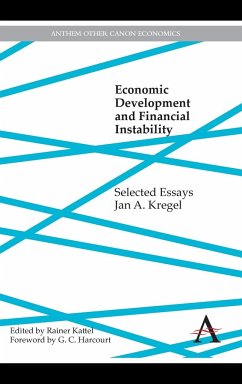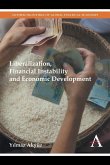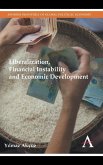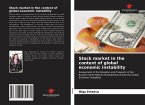Jan A. KregelSelected Essays
Economic Development and Financial Instability
Selected Essays
Herausgeber: Kattel, Rainer
Jan A. KregelSelected Essays
Economic Development and Financial Instability
Selected Essays
Herausgeber: Kattel, Rainer
- Gebundenes Buch
- Merkliste
- Auf die Merkliste
- Bewerten Bewerten
- Teilen
- Produkt teilen
- Produkterinnerung
- Produkterinnerung
Jan A. Kregel is one of the most important post-Keynesian economists alive. These essays deal with topics ranging from financial crisis in developing countries to today's financial regulations in the US. This key collection examines crises and their impact on growth from post-Keynesian and Minskyean perspectives.
Andere Kunden interessierten sich auch für
![Liberalization, Financial Instability and Economic Development Liberalization, Financial Instability and Economic Development]() Y¿lmaz AkyüzLiberalization, Financial Instability and Economic Development68,99 €
Y¿lmaz AkyüzLiberalization, Financial Instability and Economic Development68,99 €![Liberalization, Financial Instability and Economic Development Liberalization, Financial Instability and Economic Development]() Y¿lmaz AkyüzLiberalization, Financial Instability and Economic Development156,99 €
Y¿lmaz AkyüzLiberalization, Financial Instability and Economic Development156,99 €![Ethnic Diversity and Economic Instability in Africa Ethnic Diversity and Economic Instability in Africa]() Ethnic Diversity and Economic Instability in Africa123,99 €
Ethnic Diversity and Economic Instability in Africa123,99 €![Ethnic Diversity and Economic Instability in Africa Ethnic Diversity and Economic Instability in Africa]() Ethnic Diversity and Economic Instability in Africa42,99 €
Ethnic Diversity and Economic Instability in Africa42,99 €![Property Rights Property Rights]() Property Rights77,99 €
Property Rights77,99 €![Stock market in the context of global economic instability Stock market in the context of global economic instability]() Olga ErtsevaStock market in the context of global economic instability41,99 €
Olga ErtsevaStock market in the context of global economic instability41,99 €![Entrepreneurship in the Face of Instability Entrepreneurship in the Face of Instability]() Maya CaracallaEntrepreneurship in the Face of Instability25,99 €
Maya CaracallaEntrepreneurship in the Face of Instability25,99 €-
-
-
Jan A. Kregel is one of the most important post-Keynesian economists alive. These essays deal with topics ranging from financial crisis in developing countries to today's financial regulations in the US. This key collection examines crises and their impact on growth from post-Keynesian and Minskyean perspectives.
Hinweis: Dieser Artikel kann nur an eine deutsche Lieferadresse ausgeliefert werden.
Hinweis: Dieser Artikel kann nur an eine deutsche Lieferadresse ausgeliefert werden.
Produktdetails
- Produktdetails
- Verlag: Anthem Press
- Seitenzahl: 376
- Erscheinungstermin: 15. Oktober 2014
- Englisch
- Abmessung: 235mm x 157mm x 27mm
- Gewicht: 760g
- ISBN-13: 9781783083824
- ISBN-10: 1783083824
- Artikelnr.: 41646033
- Herstellerkennzeichnung
- Libri GmbH
- Europaallee 1
- 36244 Bad Hersfeld
- gpsr@libri.de
- Verlag: Anthem Press
- Seitenzahl: 376
- Erscheinungstermin: 15. Oktober 2014
- Englisch
- Abmessung: 235mm x 157mm x 27mm
- Gewicht: 760g
- ISBN-13: 9781783083824
- ISBN-10: 1783083824
- Artikelnr.: 41646033
- Herstellerkennzeichnung
- Libri GmbH
- Europaallee 1
- 36244 Bad Hersfeld
- gpsr@libri.de
Jan A. Kregel, Edited by Rainer Kattel, Foreword by G. C. Harcourt
Foreword by G. C. Harcourt
Publication History
I. Theoretical Discussions
1. Financial Markets and Economic Development: Myths and Institutional Reality
2. External Financing for Development and International Financial Instability
3. Capital Flows: Globalization of Production and Financing Development
4. Some Risks and Implications of Financial Globalization for National Policy Autonomy
5. Two Views on the Obstacles to Development
6. Can We Create a Stable International Financial Environment that Ensures Net Resource Transfers to Developing Countries?
7. Natural Instability of Financial Markets
8. Trying to Serve Two Masters: The Dilemma of Financial Regulation
II. Finance for Development
9. East Asia Is Not Mexico: The Difference Between Balance of Payments Crises and Debt Deflations
10. "Yes 'IT' Happened Again": The Minsky Crisis in Asia
11. Financial Liberalization and Domestic Policy Space: Theory and Practice with Reference to Latin America
12. Derivatives and Global Capital Flows: Applications to Asia
13. Was There an Alternative to Brazilian Crisis?
14. An Alternative View of the Argentine Crisis: Structural Flaws in Structural Adjustment Policy
15. The Discrete Charm of the Washington Consensus
III. The Crisis in the US and the EU
16. Alternative Economic Analyses of German Monetary and Economic Unification: Monetarist and Post Keynesian
17. Currency Stabilisation through Full Employment: Can EMU Combine Price Stability with Employment and Income Growth?
18. Minsky's "Cushions of Safety," Systemic Risk and the Crisis, in the Subprime Mortgage Market
19. Why Don't the Bailouts Work? Design of a New Financial System versus a Return to Normalcy
20. Is This the Minsky Moment for Reform of Financial Regulation?
21. Debtors' Crisis or Creditors' Crisis? Who Pays for the European Sovereign and Subprime Mortgage Losses?
22. Six Lessons from the Euro Crisis
23. Minsky and the Narrow Banking Proposal: No Solution for Financial Reform
Index
Publication History
I. Theoretical Discussions
1. Financial Markets and Economic Development: Myths and Institutional Reality
2. External Financing for Development and International Financial Instability
3. Capital Flows: Globalization of Production and Financing Development
4. Some Risks and Implications of Financial Globalization for National Policy Autonomy
5. Two Views on the Obstacles to Development
6. Can We Create a Stable International Financial Environment that Ensures Net Resource Transfers to Developing Countries?
7. Natural Instability of Financial Markets
8. Trying to Serve Two Masters: The Dilemma of Financial Regulation
II. Finance for Development
9. East Asia Is Not Mexico: The Difference Between Balance of Payments Crises and Debt Deflations
10. "Yes 'IT' Happened Again": The Minsky Crisis in Asia
11. Financial Liberalization and Domestic Policy Space: Theory and Practice with Reference to Latin America
12. Derivatives and Global Capital Flows: Applications to Asia
13. Was There an Alternative to Brazilian Crisis?
14. An Alternative View of the Argentine Crisis: Structural Flaws in Structural Adjustment Policy
15. The Discrete Charm of the Washington Consensus
III. The Crisis in the US and the EU
16. Alternative Economic Analyses of German Monetary and Economic Unification: Monetarist and Post Keynesian
17. Currency Stabilisation through Full Employment: Can EMU Combine Price Stability with Employment and Income Growth?
18. Minsky's "Cushions of Safety," Systemic Risk and the Crisis, in the Subprime Mortgage Market
19. Why Don't the Bailouts Work? Design of a New Financial System versus a Return to Normalcy
20. Is This the Minsky Moment for Reform of Financial Regulation?
21. Debtors' Crisis or Creditors' Crisis? Who Pays for the European Sovereign and Subprime Mortgage Losses?
22. Six Lessons from the Euro Crisis
23. Minsky and the Narrow Banking Proposal: No Solution for Financial Reform
Index
Foreword by G. C. Harcourt
Publication History
I. Theoretical Discussions
1. Financial Markets and Economic Development: Myths and Institutional Reality
2. External Financing for Development and International Financial Instability
3. Capital Flows: Globalization of Production and Financing Development
4. Some Risks and Implications of Financial Globalization for National Policy Autonomy
5. Two Views on the Obstacles to Development
6. Can We Create a Stable International Financial Environment that Ensures Net Resource Transfers to Developing Countries?
7. Natural Instability of Financial Markets
8. Trying to Serve Two Masters: The Dilemma of Financial Regulation
II. Finance for Development
9. East Asia Is Not Mexico: The Difference Between Balance of Payments Crises and Debt Deflations
10. "Yes 'IT' Happened Again": The Minsky Crisis in Asia
11. Financial Liberalization and Domestic Policy Space: Theory and Practice with Reference to Latin America
12. Derivatives and Global Capital Flows: Applications to Asia
13. Was There an Alternative to Brazilian Crisis?
14. An Alternative View of the Argentine Crisis: Structural Flaws in Structural Adjustment Policy
15. The Discrete Charm of the Washington Consensus
III. The Crisis in the US and the EU
16. Alternative Economic Analyses of German Monetary and Economic Unification: Monetarist and Post Keynesian
17. Currency Stabilisation through Full Employment: Can EMU Combine Price Stability with Employment and Income Growth?
18. Minsky's "Cushions of Safety," Systemic Risk and the Crisis, in the Subprime Mortgage Market
19. Why Don't the Bailouts Work? Design of a New Financial System versus a Return to Normalcy
20. Is This the Minsky Moment for Reform of Financial Regulation?
21. Debtors' Crisis or Creditors' Crisis? Who Pays for the European Sovereign and Subprime Mortgage Losses?
22. Six Lessons from the Euro Crisis
23. Minsky and the Narrow Banking Proposal: No Solution for Financial Reform
Index
Publication History
I. Theoretical Discussions
1. Financial Markets and Economic Development: Myths and Institutional Reality
2. External Financing for Development and International Financial Instability
3. Capital Flows: Globalization of Production and Financing Development
4. Some Risks and Implications of Financial Globalization for National Policy Autonomy
5. Two Views on the Obstacles to Development
6. Can We Create a Stable International Financial Environment that Ensures Net Resource Transfers to Developing Countries?
7. Natural Instability of Financial Markets
8. Trying to Serve Two Masters: The Dilemma of Financial Regulation
II. Finance for Development
9. East Asia Is Not Mexico: The Difference Between Balance of Payments Crises and Debt Deflations
10. "Yes 'IT' Happened Again": The Minsky Crisis in Asia
11. Financial Liberalization and Domestic Policy Space: Theory and Practice with Reference to Latin America
12. Derivatives and Global Capital Flows: Applications to Asia
13. Was There an Alternative to Brazilian Crisis?
14. An Alternative View of the Argentine Crisis: Structural Flaws in Structural Adjustment Policy
15. The Discrete Charm of the Washington Consensus
III. The Crisis in the US and the EU
16. Alternative Economic Analyses of German Monetary and Economic Unification: Monetarist and Post Keynesian
17. Currency Stabilisation through Full Employment: Can EMU Combine Price Stability with Employment and Income Growth?
18. Minsky's "Cushions of Safety," Systemic Risk and the Crisis, in the Subprime Mortgage Market
19. Why Don't the Bailouts Work? Design of a New Financial System versus a Return to Normalcy
20. Is This the Minsky Moment for Reform of Financial Regulation?
21. Debtors' Crisis or Creditors' Crisis? Who Pays for the European Sovereign and Subprime Mortgage Losses?
22. Six Lessons from the Euro Crisis
23. Minsky and the Narrow Banking Proposal: No Solution for Financial Reform
Index








